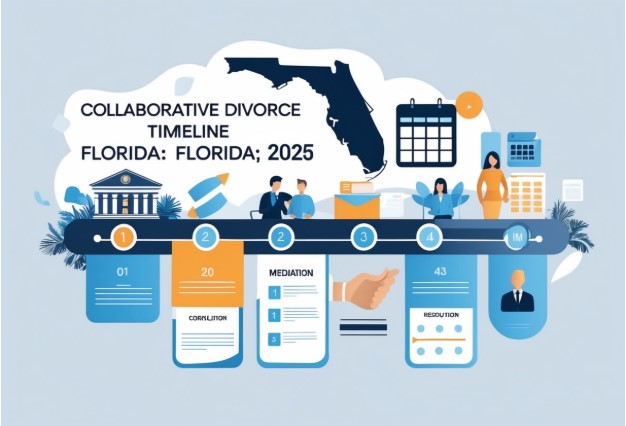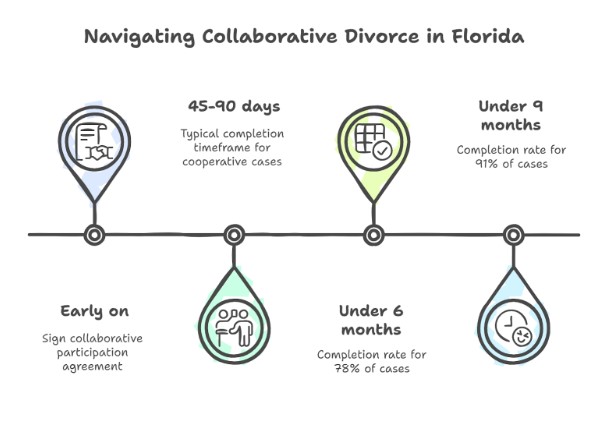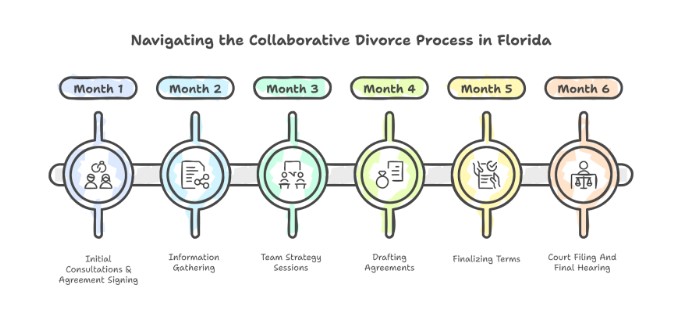Collaborative Divorce Timeline in Florida (2025 Guide): Step-by-Step Process
Originally published: August 2025 | Reviewed by Carol Ann Mazza

The collaborative divorce timeline in Florida gives couples a smoother—and often faster—option than the traditional divorce process.
Instead of dragging things out in court, collaborative divorce relies on cooperation between spouses and their teams.
Usually, this process takes a few months, depending on how quickly everyone communicates and settles the main issues.
During a collaborative divorce, a family lawyer trained in this approach helps the couple discuss property division, child custody, and support openly.
This method bypasses the courtroom drama, making the whole process less stressful for everyone.
Understanding the timeline is crucial if you’re even considering divorce in Florida. It enables you to plan and tackle the emotional and practical challenges that come with the territory.
If you want a private, respectful way to end your marriage, this guide will walk you through what happens at each stage of the collaborative divorce process in 2025.
Key Takeaways
- Collaborative divorce in Florida typically takes 4–8 months, with 78% of cases completing within 6 months, which is far faster than traditional litigation.
- The process follows a month-by-month structure, including team selection, information exchange, negotiation, and final court approval with minimal hearings.
- Choosing collaborative divorce can save time, money, and emotional strain, especially for families who prioritize privacy and cooperative parenting.
- Florida offers one of the most successful collaborative divorce frameworks, with over 91% of cases reaching complete agreement outside of court.
How Long Does Collaborative Divorce Take In Florida?

The length of a collaborative divorce in Florida varies. It depends on factors such as the complexity of your situation and the willingness of both parties to cooperate.
Unlike the old-school route, collaborative divorce depends on open communication and teamwork. If you both stay on the same page, the process typically wraps up in 45 to 90 days; however, it may stretch out to several months if issues arise, especially with finances or child custody.
Florida Academy of Collaborative Professionals stat:
“78% of collaborative divorce cases in Florida are completed in under 6 months, and 91% in under 9 months.
Early on, both parties sign a collaborative participation agreement (sometimes called a collaborative law participation agreement). This agreement states that you’ll work things out together, rather than in court.
Lawyers, financial experts, and sometimes mental health pros help guide negotiations. The aim is to reach an uncontested divorce agreement through this cooperative approach.
Because everyone focuses on mutual respect and privacy, you typically avoid the delays associated with litigation. The timeline stays flexible, depending on how quickly you can agree on the significant issues.
Begin your divorce journey with clarity and confidence. CollaborativeNow offers structured collaborative divorce services designed to help you avoid court. Contact us today to get started.
If you’re ready to get started, call us now!
Month-By-Month Collaborative Divorce Timeline (Florida)

The collaborative divorce process in Florida follows a clear, paced timeline. Couples work through important decisions step by step—meeting with lawyers, sharing information, planning strategies, negotiating terms, and finalizing agreements before heading to court.
Month 1 – Initial Consultations & Agreement Signing
In the first month, each spouse meets separately with their collaborative attorney. These meetings help clarify goals and explain the collaborative process.
After that, both parties come together for a joint meeting with their attorneys to sign the Participation Agreement. This agreement locks in everyone’s commitment to resolve issues outside of court through cooperation.
They discuss significant topics, including custody, alimony, spousal support, child support, and dividing property. By the end of the month, the team sets ground rules and schedules future meetings.
Month 2 – Information Gathering
In the second month, both sides collect and share all the necessary financial and family info. Think income statements, tax returns, marital assets and debts, plus school and health records for the kids.
Full disclosure is crucial for making fair decisions regarding property division, parenting plans, child support, and alimony. Attorneys and sometimes financial experts help check the information.
Transparency here fosters trust and enables the team to identify both agreements and sticking points early on.
Month 3 – Team Strategy Sessions
By the third month, the couple, their attorneys, and sometimes other experts, such as financial advisors or therapists, sit down for strategy sessions. These talks focus on key issues, including child custody, visitation, and spousal support.
The group outlines possible solutions and compromises. Parenting plans receive a close review to ensure the kids’ needs take priority while accommodating everyone’s schedules.
Negotiation and cooperation take center stage in this scenario. The point is to avoid litigation and focus on lasting agreements, even if it takes a few tries to get it right.
Month 4 – Drafting Agreements
In the fourth month, attorneys begin drafting detailed agreements based on the decisions made so far. These drafts cover alimony, child support calculations, splitting up assets and debts, and parenting schedules.
They review and tweak these drafts in meetings. Both sides can suggest changes and ask questions, so the process stays flexible and transparent.
Honestly, this is where things start to feel real—verbal agreements turn into actual, binding documents.
Month 5 – Finalizing Terms
Month five is about ironing out any remaining disputes and finalizing the terms. The couple and their team review every detail to ensure everything is fair and in line with Florida law.
If disagreements arise, they hold additional negotiation sessions to resolve issues without resorting to court. The team pays close attention to child support and parenting plans to ensure the children’s best interests are protected.
Once everyone has signed off, the parties prepare to submit the signed agreements to the court.
Month 6 – Court Filing And Final Hearing
In the sixth month, they file the finalized documents with the family court. A final hearing is scheduled, where a judge reviews the agreements for fairness and legal compliance.
The judge might ask a few questions, but if everything checks out, they approve the agreements. That’s it—the divorce becomes official.
With this step, the process concludes, and both individuals can begin their post-divorce lives with clear, agreed-upon arrangements.
Collaborative Divorce vs Traditional Divorce Timeline
| Aspect | Collaborative Divorce | Traditional Litigation |
| Avg. Duration (FL) | 4–8 months | 12–18+ months |
| Court Appearances | 1 (final hearing) | Multiple hearings |
| Discovery Process | Voluntary | Compulsory, often delayed |
| Attorney Hours | Shared neutral professionals | Individual attorney preparation |
| Emotional Cost | Lower | Higher (adversarial tone) |
In Florida, collaborative divorce resolves approximately 2–3 times faster than litigation on average.
Wondering if you and your spouse are a fit for family mediation? CollaborativeNow guides Florida families toward peaceful and mutually beneficial resolutions. Schedule a confidential consultation today to discover how we can assist you.
If you’re ready to get started, call us now!
Factors That Influence Timeline In Florida
The duration of a collaborative divorce in Florida depends on several key factors. These include how well the spouses get along, the complexity of their finances and family situation, and whether the right professionals are available to assist with the collaborative law process.
Level Of Conflict Between Spouses
How much the spouses argue shapes the timeline. If they can maintain a respectful tone, share relevant information, and focus on finding solutions, everything moves more efficiently.
However, if conflict escalates, progress slows down. Sometimes, they may require additional sessions or outside assistance.
When child custody or relocation issues arise, emotions can become intense. Disagreements over paternity or parenting plans add even more time.
Collaborative law promotes a cooperative approach, which can be beneficial if both parties are willing to make a genuine effort to resolve their differences.
Number Of Assets Or Children Involved
The more assets you have, the longer things can take. Detailed financial disclosures, valuations, and sometimes expert opinions all eat up time.
Business ownership or investments just add more layers. If you have multiple children or challenging custody issues, expect the timeline to be extended.
Working out fair parenting time, sorting out paternity if it’s unclear, and handling relocation requests all require careful talks. Each topic needs real attention to protect everyone involved.
Availability Of Collaborative Professionals
The process goes smoother—and faster—if you can get the right professionals, like attorneys, financial advisors, and mental health experts. These folks help keep things calm and thorough.
If they’re busy or difficult to schedule, you might have to wait longer. Some cases require the expertise of child specialists for custody or relocation questions. Coordinating everyone’s calendars affects how quickly you wrap things up.
Tips To Keep Your Collaborative Divorce On Track
Staying focused helps a collaborative divorce move along. The couple should set clear priorities and maintain open communication with their collaborative team.
This typically involves attorneys, financial neutrals, and occasionally a mental health professional. Working together reduces surprises and delays.
It’s essential to treat the process as a voluntary settlement. When both sides want a peaceful resolution, there’s less risk of ending up in court.
If you encounter a roadblock, mediation can help break the impasse. Keeping meetings organized and on schedule makes a big difference. Both parties should arrive with all the necessary documents and information ready to proceed.
This saves time and reduces costs. If things get emotional—and let’s be honest, they often do—a mental health professional can help steer conversations back to solutions.
Sticking to a budget and bringing in a financial neutral helps prevent money issues from slowing things down. That way, both sides can see that the numbers are fair and clear.
If you stay committed and keep things peaceful, you’ve a much better chance of achieving a good outcome.
Collaborative divorce isn’t about winning or losing—it’s about finding solutions that work for everyone.
Florida-Specific Statistics: Completion Rates & Success
Collaborative divorce in Florida has been shown to have high success and completion rates. The Florida Academy of Collaborative Professionals (FACP) reports that 92% of collaborative cases result in a full and mutually agreed-upon agreement.
Generally, most couples can resolve their issues without resorting to court. That’s a big deal, if you ask anyone who has ever been through a tough divorce.
The timeline’s pretty fast, too. FACP claims that 95% of collaborative divorces are finalized within one year.
Even more impressive, 84% wrap up in under nine months. Compare that to traditional litigation, which can seem to drag on forever.
People in Florida tend to lean toward collaborative divorce because it emphasizes cooperation and mutual respect. The Family Law collaborative process act encourages respectful negotiation, not endless fighting.
This approach helps keep stress and costs down. Let’s be honest, nobody wants more drama or bigger bills.
Other numbers support this: 85% of couples reach a full settlement agreement. And 78% finalize their divorce in less than six months.
The collaborative law process provides a faster and more efficient alternative to traditional court battles.
Costs? They’re usually lower, too. Studies show that many couples spend less than $25,000 per spouse, often less than what litigation costs.
Of course, this only works if both sides negotiate honestly and adhere to the agreement. If one person checks out, the whole thing can fall apart.
Conclusion
Collaborative divorce provides couples in Florida with a way to end their marriage with greater respect and clarity.
Instead of fueling conflict, this process leans into cooperation and typically concludes more quickly than a drawn-out court battle.
Trained attorneys jump in to guide both spouses through each step. They sit down together to sort out matters such as property, child custody, and support, always seeking solutions that work for everyone at the table.
Key benefits include:
- Privacy, since most discussions stay out of court
- Reduced stress through open communication
- Control over decisions without a judge deciding
This process is voluntary, and both parties must genuinely commit to working together in good faith. If one person cannot agree, they can walk away and return to regular litigation.
Thinking about this route? It’s wise to consult with a collaborative divorce lawyer who is familiar with the intricacies of collaborative divorce. They’ll help you get a grip on the timeline, costs, and any legal requirements you’ll need to meet.
If you want to avoid endless court drama and maintain a healthy approach, collaborative divorce may be the better path for Florida families in 2025.
Whether you’re just exploring options or ready to file, CollaborativeNow supports you through every step of your divorce mediation process in Fort Lauderdale. Schedule your consultation now.
Contact Us Today For An Appointment
Frequently Asked Questions
How long does collaborative divorce take in Florida?
Most collaborative divorces in Florida take 4 to 8 months to complete. According to the Florida Academy of Collaborative Professionals, 78% of cases are resolved within 6 months, which is significantly faster than traditional litigation, which often takes over a year.
Is collaborative divorce faster than traditional divorce in Florida?
Yes. Collaborative divorce in Florida typically resolves in half the time of a litigated divorce. While collaborative cases generally average 4–8 months, contested divorces can take 12–18 months or longer due to court delays and formal discovery processes.
What’s the typical timeline for a collaborative divorce in Florida?
The collaborative divorce timeline in Florida includes:
- Month 1: Attorney selection and agreement signing
- Month 2–3: Financial and parenting plan discussions
- Month 4–5: Finalizing agreements
- Month 6: Court approval
Timelines vary, but most cases close within 4–8 months.
What delays collaborative divorce in Florida?
Common delays in Florida collaborative divorces include scheduling conflicts, complex financial disclosures, emotional disagreements, and uncooperative behavior. Selecting experienced professionals and preparing documents in advance can help prevent these issues.
Can collaborative divorce be completed in less than 6 months?
Yes. If both spouses are cooperative and issues are straightforward, collaborative divorce can be finalized in as little as 3 to 4 months in Florida. Factors such as minimal assets, no custody disputes, and complete transparency expedite the process.
What percentage of collaborative divorces are completed quickly in Florida?
According to the Florida Academy of Collaborative Professionals, 78% of collaborative divorce cases in the state are completed within six months, and over 91% are resolved within nine months, with high client satisfaction and success rates.
